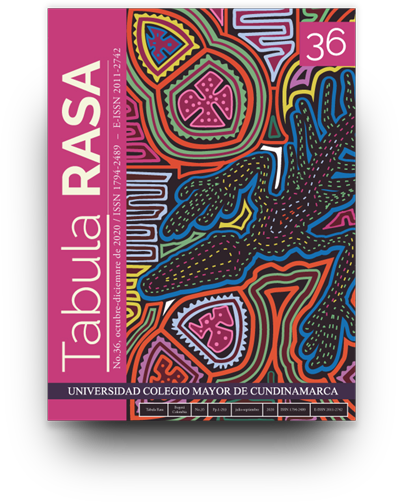Shifts in the Relations Between Wayuu and Yolujaa as a Result of Evangelical Christian Beliefs
Transformaciones en la relación entre los wayuu y Yolujaa a causa de las creencias cristianas evangélicas
Show authors biography
Ancestors play a very important role for the Wayuu people. Their relationship is based on protection, exchange and special forms of wisdom transmission. This article intends to answer the question of whether contacts between Christian and missionary notions might have transformed the relation between Wayuu members who call themselves evangelical, while they do not belong to any specific Christian church, and their ancestors, their cosmology and ontology.
Article visits 210 | PDF visits 125
Downloads
- Århem, K. & Sprenger, G. (Eds.). (2016). Animism in Southeast Asia. London/New York: Routledge.
- Bird-David, N. (1999). ‘Animism’ revisited. Personhood, Environment, and Relational Epistemology. Current Anthropology, 40 (Supplement), 67-91. http://www.jstor.org/stable/10.1086/200061
- Capitán, D. M. & Capitán, L. B. (2005). Diccionario básico ilustrado. Bogotá: Editorial Fundación para el Desarrollo de los Pueblos Marginados.
- Descola, P. (2013 [2005]). Beyond Nature and Culture. Chicago/London: The University of Chicago.
- Descola, P. (1992). Societies of Nature and the Nature of Society. En A. Kuper (Ed.). Conceptualizing Society (pp.107-126). London/New York: Routledge.
- Finol, J. E. (2007). De niña a mujer... El rito de pasaje en la sociedad contemporánea. Cuadernos de la Facultad de Humanidades y Ciencias Sociales, 17, 171-185. https://www.redalyc.org/articulo.oa?id=18501711
- Finol, J. E. (2001). Mito y cultura guajira. Contribución a la semiótica del mito guajiro. Maracaibo: Universidad del Zulia.
- Finol, J. E. & Fernández, J. Á. (2012). Etnografía del rito: reciprocidad y ritual funerario entre los guajiros. Maracaibo: Universidad del Zulia. www.joseenriquefinol.com/v4/index.php/articulos/articulos-en-espanol/23-etnografia-del-rito-reciprocidad-y-ritual-funerario-entre-los-goajiros
- García Gavidia, N. & Valbuena, C. (2004). Cuando cambian los sueños. La cultura wayuu frente a las iglesias evangélicas. Opción, 20(43), 9-28. http://www.redalyc.org/articulo.oa?id=31004301
- Goulet, J. G. (1981). El Universo social y religioso guajiro. Caracas: Universidad Católica Andrés Bello.
- Goulet, J. G. (1978). El parentesco guajiro de los apüshii y de los oupayu. Colección de lenguas indígenas, serie menor 6. Maracaibo-Caracas: Universidad Católica Andrés Bello.
- Halbmayer, E. (2019). Amerindian Sociocosmologies of Northwestern South America: Some Reflections on the Dead, Metamorphosis, and Religious Specialists. Journal of Latin American and Caribbean Anthropology, 24(1), 13-31. https://doi.org/10.1111/jlca.12381
- Halbmayer, E. (2013). Securing a Life for the Dead among the Yukpa. The Exhumation Ritual as a temporary Synchronisation of Worlds. Journal de la Société des Américanistes, 99(1), 105-140. https://doi.org/10.4000/jsa.12620
- Halbmayer, E. (2012). Amerindian Mereology: Animism, Analogy, and the Multiverse. Indiana, 29, 103-125. https://www.researchgate.net/publication/275641992_Amerindian_mereology_Animism_analogy_and_the_multiverse
- Ingold, T. (2000). The Perception of the Environment: Essays on Livelihood, Dwelling and Skill. London: Routledge.
- Ingold, T. (1996). Hunting and Gathering as Ways of Perceiving the Environment. En R. F. Ellen & K. Fukui (Eds.). Redefining nature: Ecology, Culture and Domestication, (pp.117-155). Oxford: Berg.
- Jusayú, M. Á. (1986). Achi’ki (relatos guajiros). Caracas: Universidad Católica Andrés Bello.
- Jusayú, M. Á. & Olza Zubiri, J. (1988). Diccionario sistemático de la Lengua Guajira. Caracas: Universidad Católica Andrés Bello.
- Mancuso, A. (2008). Descent among the Wayuu. Concepts and Social Meanings. Journal de la société des américanistes, 94(1), 99-126. https://doi.org/10.4000/jsa.9143
- Mancuso, A. (2020). The Place of Livestock in human-non-human Relationship among the Wayuu. En Halbmayer, E. (Ed.). Amerindian Socio-Cosmologies between the Andes, Amazonia and Mesoamerica.Toward an Anthropological Understanding of the Isthmo–Colombian Area, (pp.301-328). London: Routledge.
- Meiser, A. (2018). Christian indigenous identities and alter-native modernities in the upper Amazon. En E. Halbmayer (Ed.). Indigenous Modernities in South America, (pp.103-130). Canon Pyon: Sean Kingston Publishing.
- Morillo Arapé, A. J. & Paz Reverol, C. L. (2008). Los sueños y su importancia en el pronóstico y tratamiento de la vivienda de los wayuu en Venezuela. Gazeta de Antropología, 24(2).art. 54. http://www.gazeta-antropologia.es/?p=2302
- Mussat, E. (2009). Representaciones y técnicas del cuerpo entre wayuu pentecostales. Boletín Antropológico, 27(77), 257-280. http://www.redalyc.org/articulo.oa?id=71222499001
- Mussat, H. (2010). La Santa Cena del culto pentecostal wayuu CRAPE: rito de comunión sincrético. Opción, 26(62), 41-55. http://www.redalyc.org/articulo.oa?id=31015653004
- Nájera Nájera, M. & Lozano Santos, J. (2009). Curar la carne para conjurar la muerte. Exhumación, segundo velorio y segundo entierro entre los wayuu: rituales y prácticas sociales. Boletín de Antropología, 23(40), 11-31. https://revistas.udea.edu.co/index.php/boletin/article/view/6473/5941
- Paz Ipuana, R. (1973). Mitos, leyendas y cuentos guajiros. Caracas: Instituto Agrario Nacional.
- Perrin, M. (1997 [1992]). Los practicantes del sueño. El chamanismo wayuu. Caracas: Monte Ávila Editores Latinoamericana.
- Perrin, M. (1987 [1976]). The Way of the Dead Indians. Texas: University of Texas Press.
- Pocaterra, J. (2009). Narraciones de los abuelos wayuu. Caracas: Gobierno Bolivariano de Venezuela. http://bibliotecadigital.fundabit.gob.ve/wp-content/uploads/2019/10/ColeccionMaestro/Narraciones_abuelos_wayuu_1-32.pdf
- Segovia, Y. (1998). Crimen y otredad en la sociedad wayuu (interpretación a partir del significado mítico del «mal»). Boletín Antropológico, 44(3), 5-33. http://www.saber.ula.ve/bitstream/handle/123456789/18463/yanet_segovia.pdf;jsessionid=4AAE4C54A3D819C12A18C65BFB07DCBD?sequence=1
- Sprenger G. (2016). Graded personhood. En K. Århem y G. Sprenger (Eds.). Animism in Southeast Asia, (pp.73-90). London/New York: Routledge.
- Tinder, D. (1989). Evangelicalismo. En N. Wilton. Diccionario de Historia de la Iglesia, (p.422). Miami: Editorial Caribe.
- Vilaça, A. (2016). Praying and Preying. Christinaity in indigenous Amazonia. Oakland: Universty of California Press.
- Vilaça, A. & Wright, R. (Eds.). (2009). Native Christians. Modes and Effects of Christianity amoung indigenous People of the Americas. Aldershot: Ashgate.
- Villalba Hernández, J. A. (2008). Wayuu resistencia histórica a la violencia. Historia Caribe, 5(13), 45-64. https://www.redalyc.org/pdf/937/93751303.pdf
- Viveiros de Castro, E. (1998). Cosmological Deixis and Amerindian Perspectivism. Journal of the Royal Anthropological Institute, 4(3), 469-488. https://www.jstor.org/stable/3034157
- Viveiros de Castro, E. (1992). From the Enemy’s Point of View: Humanity and Divinity in an Amazonian Society. Chicago: University of Chicago Press.








